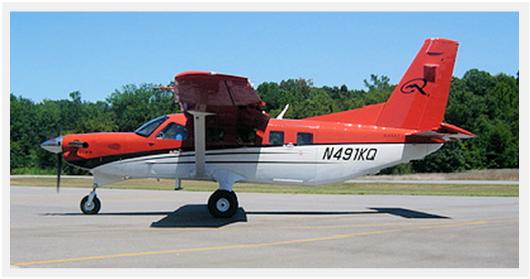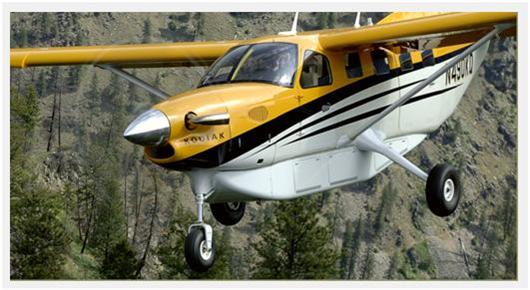Quest Kodiak: Call It Anything You Want, But Please Don't Call It A Caravan!
 Tuesday, February 3, 2009 at 11:30AM
Tuesday, February 3, 2009 at 11:30AM Hey, don’t misunderstand. The Caravan is an awesome airplane with a fabulous work history. With over 1,500 built since the Cessna ‘big boy’ single was first intro’d in 1984, the Caravan can only be described as a huge success.
But calling the Quest Kodiak a Caravan is kinda like calling a chimpanzee a monkey. Yeah, they look a lot alike, but the truth is that they’re really an all together different animal. Stick with me til the end and I’ll help you see the differences both inside and out.
Sure, the basic planform is similar between the two, but the Kodiak is more compact, especially in the aft fuselage. It’s quite a bit shorter behind the big door than the Caravan, even tho the overall cabin length is pretty close to the same. This has the fab effect of helping to reduce the weight of the structure. Anytime you can get the airframe to accomplish the goal with less weight (without sacrificing any safety), you are gonna come out ahead.
The people at Quest Aircraft have worked really hard to engineer an airplane that’s really light while at the same time being extra, extra beefy. Compare the fact that both airplanes have useful loads within about 200 pounds of each other (possibly much closer depending on how you read the published numbers), but the Kodiak does it with a gross weight that’s 1,250 pounds less than the Caravan. That's a huge difference!
Far from being a lightweight though, the Kodiak has been designed from the ground up to work in the environment of airplanes like the de Havilland Beaver and Otter, or the Pilatus Porter. Backwoods or jungle aircraft that routinely operate off the ‘earth’, but not so much out of ‘airports’.
The Quest Aircraft Kodiak was meant to be a workhorse in the humanitarian and missionary markets before the first sketches were ever made. This is specifically what it’s made for, and it’s simply far better suited to this kind of work than the Cessna Caravan was meant to be.

Quest Aircraft KODIAK (photo: flickr.com/photos/sfsutton)

Cessna CARAVAN (photo: businesswings.com/de/en/home)
The much lighter Kodiak airframe has been mated to a bulletproof Pratt & Whitney PT-6 kerosene burner that puts out a max continuous of 700hp (25 more than Caravan). It’s the 750hp available for take-off that will really get your attention tho.
With large fowler flaps and an advanced STOL wing design, the Kodiak can shatter the grip of gravity at full gross weight in just 750’ of ground roll! Again, the Caravan is a great airplane, but it simply can’t come close to that kind of STOL performance. The Kodiak isn’t a slow poke either. In fact, both aircraft pull their way thru the sky at essentially the same 185ktas cruise speed.
In the cockpit, the Kodiak has been built around the Garmin G1000 integrated flight instrument system as standard equipment. This not only helps to reduce pilot workload, but should prove to be very beneficial while operating in remote areas due to the more rugged nature of the system and the ease maintenance.
The Kodiak cabin is a little narrower and shorter than the Caravan, but a little taller overall. Both have 2 seats up front and 8 in the back, tho Caravan can go 3 seats across and push a crowded cabin to 12 seats plus the 2 up front. The bottom line is that the Kodiak is a smaller airplane, tho not by much, and again, has a nearly identical useful load.
You can also buy a Kodiak for about $400,000 less than a Caravan, but be prepared to wait. Demand has exceeded expectations and the order backlog is currently about 3 years (keep this success story in mind when you get feeling bad about the economy and the future of aviation!) There’s also hope that they’ll be able to bring the delay down, but the company is being careful to ramp up production in a calm, orderly manner.
Quest Aircraft is based in Sandpoint, a really nice little resort community settled in around the mountains of far northern Idaho, and currently employs about 250 people.


First JAARS Kodiak (photo: ottavianotes.blogspot.com )
It’s an interesting point to note that the Kodiak began as a project of Tom Hamilton from Stoddard-Hamilton and Glasair fame (according to Wikipedia, Tom named that company by taking his middle and last names to make it sound like a big time operation - works for me!) So, while the Kodiak is a mostly aluminum airplane, unlike the composite Glasairs, you can see where the drive for performance was coming from.
If you are 'plane-spotting' and you wanna get the Kodiaks separated from the Caravans, look for these details: The Kodiak has exhaust stacks on both sides, Caravan only on the right / Kodiak has the pointy ’mouth’ intake below the spinner / Kodiak has large fowler flap rails that are easily visible / Kodiak has the much shorter aft fuselage / and the Kodiak has a leading edge cuff on the outer wing panels.
The closer you look, the more you realize that this is much different aircraft than a Caravan. There’s good news tho, for both Cessna and Quest, in that both airplanes will likely continue to be great selling workhorses for a really long time.
In my mind however, the most important feature of the Kodiak is that it was designed from day one to be used in missionary aviation. I don’t think there’s a more important use for an aircraft than this. I’m really glad to see that it excels in this role, and I appreciate Quest aircraft and their dedication to this goal.
The blue Kodiak above is serial number 008 and was recently delivered to Waxhaw, NC andJAARS, which originally stood for: Jungle Aviation And Radio Service. Over the years, this missionary outreach organization has grown to include many additional services so that it’s really not an acronym anymore, it’s simply the name they go by. This is their first Kodiak, and is scheduled to head to Papua New Guinea in August 2009 after an extensive training program is completed.
My dad, who recently passed away, was an enthusiastic supporter of JAARS, and I know of one friend who made a donation to JAARS in his name. Maybe you would consider a donation to them as well? You can help support their mission, and their brand new Kodiak!
 Martt |
Martt |  11 Comments |
11 Comments |  Kodiak,
Kodiak,  Quest
Quest  Email Article
Email Article 














































































Reader Comments (11)
Why do you misspell the word "though" as "tho."
Thanks for your thoughtful analysis. We are currently analyzing Caravan, Kodiak's, Porters, and Otters for our mission. Parts and support will be critical factors too. Caravan's and Otters are available today on the market. Porters are in limited supply as the Kodiak is. It's great to have these choices. All are great planes.
It is so annoying mentioning the word "missionary" so many times in an article dedicated to aviation.
only if you are bothered by such things alex.
Missionary, missionary, missionary, missionary, missionary, missionary, missionary, missionary, missionary etc...
ps thanks for the post
I agree that it is a strong plane but the usefull load does not come close to that of a caravan, 800 lbs different in practical situation but than again it is not a caravan and it was not build to resemble one either.. For commercial work the usefull load, especially the reduced landing weigt , is not that great. I also fly a pac750, the quality of the airframe is not as beefy as a pac but it hauls 600 pounds more than a kodiak with the same engine...
I've noticed that you keep referring to the Caravan being longer, heavier, etc. HOWEVER, remember the Caravan "A" model that's shorter and lighter than the "B" model that you are comparing to, granted, the "A" model Caravan is no longer in production.......but the Kodiak looks "suspiciously" like a Caravan. "0" points for originality.
"Missionary" only occurs twice. It was a legitimate description of the history of the plane.
Thank you for this great article. I really appreciate your unbiassed look and comparison of these wonderful aircraft. I love the fact that the Kodiak is the first to be built strictly with the Mission Field in mind and hopefully, raising the level of Missionary Aviation SAFTEY!
How is 'missionary aviation' different from any other type of bush piloting?
jayjuzivia e3d3fd1842 https://ghosted.com/maiderraupo
My family was one of the first missionaries to be serviced by this Kodiak (008). This plane was definitely built for missionary aviation, and we were impressed with the performance, cargo space, large cargo doors, big tires for softer, muddy airstrip, and STOL capabilities. It was far superior to the Avgas Cessna 206s we were used to in every way.
This plane (008) carried us and several families and our cargo from Ukarumpa, Papua New Guinea, (surrounded by high mountains), to the Sepik River region (Wewak) several times, and later out to our challenging bush airstrip - a green postage stamp cut from the hillside of a rainforest.
Over the years we grew to love this aircraft even more as it was later fitted with a cargo pod and certified with increased cargo weight capacity. The large doors were perfect for shipping water tanks out to the village for humanitarian water projects, as well as being used as an ambulance for medical emergencies. Many lives from the remote village we worked in over 20 years were literally saved as injured or sick patients were flown to the Wewak Hospital for life-saving treatment.
We are so glad to be part of this incredible aircraft's journey toward success, and we are so thankful for our wonderful, skilled, and hard working pilots.